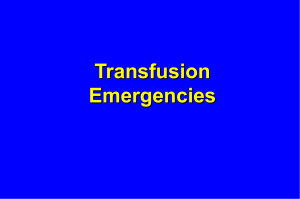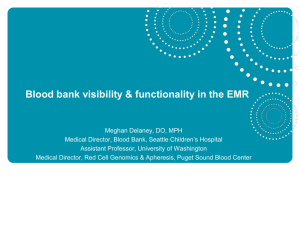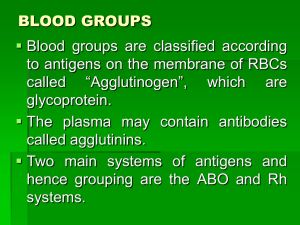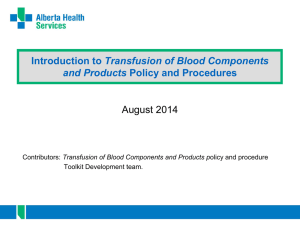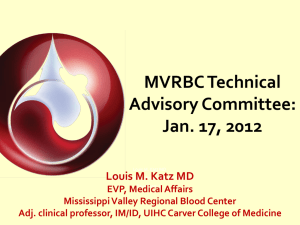Blood Transfusions - School of Medicine, Queen`s University
advertisement
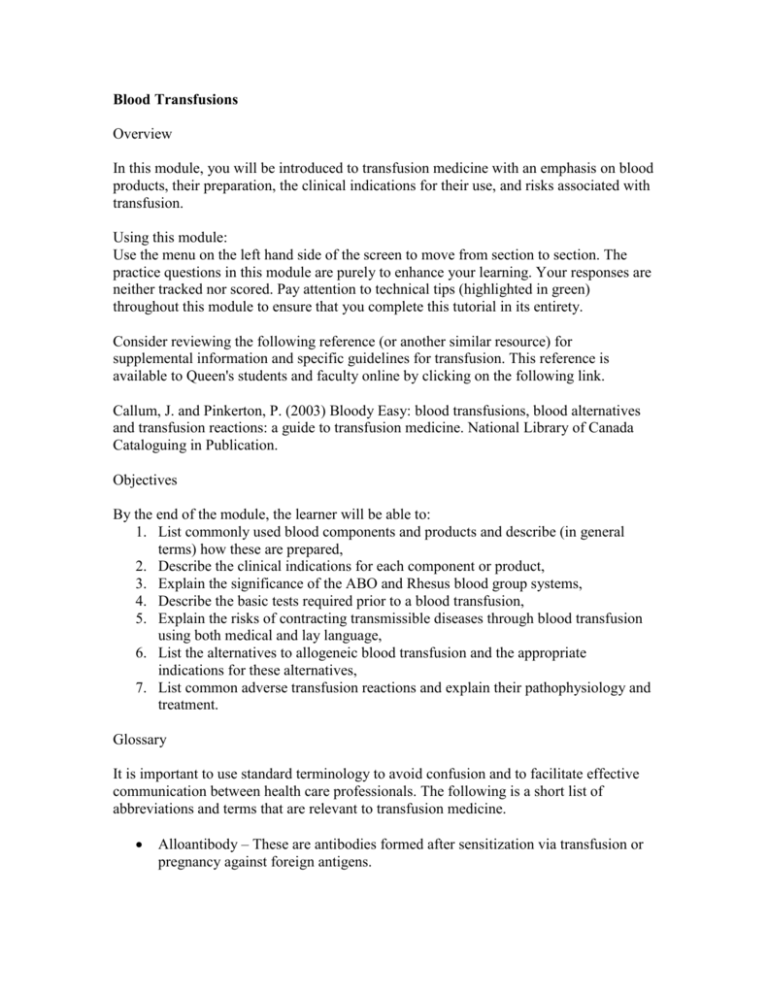
Blood Transfusions Overview In this module, you will be introduced to transfusion medicine with an emphasis on blood products, their preparation, the clinical indications for their use, and risks associated with transfusion. Using this module: Use the menu on the left hand side of the screen to move from section to section. The practice questions in this module are purely to enhance your learning. Your responses are neither tracked nor scored. Pay attention to technical tips (highlighted in green) throughout this module to ensure that you complete this tutorial in its entirety. Consider reviewing the following reference (or another similar resource) for supplemental information and specific guidelines for transfusion. This reference is available to Queen's students and faculty online by clicking on the following link. Callum, J. and Pinkerton, P. (2003) Bloody Easy: blood transfusions, blood alternatives and transfusion reactions: a guide to transfusion medicine. National Library of Canada Cataloguing in Publication. Objectives By the end of the module, the learner will be able to: 1. List commonly used blood components and products and describe (in general terms) how these are prepared, 2. Describe the clinical indications for each component or product, 3. Explain the significance of the ABO and Rhesus blood group systems, 4. Describe the basic tests required prior to a blood transfusion, 5. Explain the risks of contracting transmissible diseases through blood transfusion using both medical and lay language, 6. List the alternatives to allogeneic blood transfusion and the appropriate indications for these alternatives, 7. List common adverse transfusion reactions and explain their pathophysiology and treatment. Glossary It is important to use standard terminology to avoid confusion and to facilitate effective communication between health care professionals. The following is a short list of abbreviations and terms that are relevant to transfusion medicine. Alloantibody – These are antibodies formed after sensitization via transfusion or pregnancy against foreign antigens. DAT – The direct antiglobulin test (or direct Coombs test) detects antibodies bound to the surface of RBCs. DDAVP – (or desmopressin) is a drug that promotes the release of VWF and factor VIII used in patients with certain coagulation disorders. DIC – Disseminated intravascular coagulation is the life-threatening process whereby blood begins to coagulate throughout the body, consuming platelets and coagulation factors in the process, leading to an increased risk of bleeding. IAT – The indirect antiglobulin test (or indirect Coombs test) detects unbound antibodies in the patient’s serum. Massive transfusion – This refers to the replacement of the entire blood volume within a 24-hour period. Microvascular hemorrhage – This may manifest as bleeding from IV sites, mucosal bleeding or peritoneal hemorrhage. Microvascular hemorrhage may be due to thrombocytopenia, or an underlying condition such as DIC. Plasma – This is the protein-rich liquid component of blood. Platelet – These are cellular fragments involved in blood clotting. PT/INR – The prothrombin time or international normalized ratio are measures of time of the extrinsic pathway of coagulation. PTT – The partial thromboplastin time is a measure of time of the intrinsic pathway of coagulation. RBC – Red blood cells, or erythrocytes, are cells involved in oxygen transport. Serum – This refers to plasma in which the clotting factors have been removed by allowing the blood to coagulate. VWF – Von Willebrand factor is a glycoprotein involved in coagulation. WBC – White blood cells, or leukocytes, are cells involved in the immune response. Introduction Approximately every minute of every day, someone in Canada needs blood. (Canadian Blood Services) Blood transfusions have become an integral part of the treatment of many blood diseases, in the management of trauma, and in the operative setting. Given this central role of blood transfusions in modern medicine, every physician should have a solid understanding of the indications, risks and benefits of this therapy. Clinical case #1 Presentation A 25-year-old man is transfused with one unit of RBCs following a motor vehicle accident during which he suffered internal bleeding. Five minutes into the transfusion, he becomes anxious and begins to complain of chills, chest pain and a burning sensation at the IV site. It is noted that his temperature is rising and his urine is turning pink. This clinical case will be revisited later in the module. For now, consider the following questions, drawing from your readings and your background knowledge: What type of transfusion reaction do you think has occurred? What is the most common cause of this complication? What is the appropriate treatment? Foundations Blood is a specialized circulating connective tissue containing cells suspended in plasma. In a normal sized human, the total blood volume is about 5 litres. The blood cells, or formed elements, which represent approximately 45% of the blood volume, are the RBCs, WBCs and platelets. The remaining 55% of the blood volume is the plasma, which is an aqueous solution containing a number of proteins, including the coagulation factors. Blood testing Introduction Blood from a donor is collected as a unit of whole blood containing both cellular and plasma components. In Canada, blood is collected and tested by the Canadian Blood Services and Hema Quebec. The collected blood must be ABO grouped, Rhesus typed, tested for compatibility and screened for transmissible diseases before use in a transfusion. A sample of blood from a patient who may require a blood product undergoes a Type and Hold. In this procedure, ABO and Rh grouping as well as an antibody screen are performed. In addition, the plasma from the sample is stored for crossmatching when a transfusion becomes necessary. ABO grouping To determine the particular ABO blood group of a sample of blood, the forward and reverse grouping tests are performed. In the forward grouping test, the patient’s RBCs are mixed with reagent anti-A and anti-B antisera. Agglutination indicates a positive test. In the reverse grouping test, the patient’s plasma is mixed with reagent A and B RBCs. Again, agglutination indicates a positive test. Rh grouping Blood is tested next for the presence of D antigen to determine the Rh type of the sample. Anti-D antiserum is added to the patient’s RBCs and the sample is observed for agglutination. This test describes the blood as either Rh positive or Rh negative. Antibody screening All individuals receiving blood products must also undergo an antibody screen which detects common alloantibodies in the patient’s plasma which may react with transfused blood containing the particular antigen against which the alloantibody is directed. Patients having received multiple transfusions in the past or who have been pregnant are at an increased risk of having these alloantibodies in their plasma because of increased opportunity of sensitization to foreign antigen. In the antibody screen, the patient’s plasma is mixed with a number of laboratory Group O cells with known common red cell antigens. Using the IAT and observing for agglutination, this method allows for the detection of most unexpected antibodies to the common red cell antigens (ie. Kell, Duffy, Kidd, Lewis, etc.). Crossmatching The final test confirming compatibility performed on blood about to be transfused is called the crossmatch. In this test, a sample of RBCs from the specific unit of blood selected for transfusion is tested against the patient’s plasma. After grouping and antibody screening have been performed, the main purpose of crossmatching is to confirm ABO compatibility between the donor and the recipient of a blood transfusion. There are three main types of crossmatching tests: Immediate spin crossmatch – this test which takes 5-10 minutes is performed at room temperature and confirms ABO compatibility as the patient’s plasma is tested against donor RBCs and observed for agglutination and/or hemolysis. Antiglobulin crossmatch – this test which takes 30-60 minutes is performed at 37°C and an antiglobulin test is carried out on the mixture of patient’s plasma and donor RBCs to check for agglutination. This test is mandatory for patients with RBC alloantibodies. In the electronic crossmatch, a computer matches compatible units of blood from the blood bank to patients directly. Screening for transmissible diseases. Canadian Blood Services (CBS) tests each unit of blood for the following transmissible diseases: Hepatitis B Hepatitis C West Nile Virus Human Immunodeficiency Virus (HIV-1 and HIV-2) Human T-Cell Lymphotropic Virus (HTLV-I and HTLV-II) Syphilis Blood components Introduction A unit of whole blood is processed through a series of centrifugations into four main derivatives for transfusion into the recipient: Red cell concentrate Platelet concentrate Frozen plasma Cryoprecipitate Blood component therapy should be guided by both the clinical setting and laboratory data to support the need for a specific product. The risks and benefits of transfusion should always be considered. Red cell concentrate Red blood cells are indicated for the patient with increasing oxygen demands, for example in a case of acute blood loss. Normally, a rise in hemoglobin concentration of about 10 g/L is expected with every unit of red cells transfused into an adult. Note that RBCs are only compatible with normal saline. Generally, for a patient with a hemoglobin of: >100 g/L, it is likely inappropriate to give the RBC concentrate. 70-100 g/L, it is likely to be appropriate to give the RBC concentrate if there are signs or symptoms of impaired O2 delivery. <70 g/L, it is likely to be appropriate to give the RBC concentrate. Platelet concentrate Platelets are indicated in a variety of clinical scenarios. Generally, in the setting of bleeding secondary to thrombocytopenia, platelets should be transfused (this is unlikely in the patient with a platelet count >50). In addition, platelets should be transfused prophylactically in the patient whose platelet count is <10 and in whom the thrombocytopenia is expected to last a short period of time. Each unit of platelets contains a small volume of RBCs. As such, ABO/Rh compatible platelets are preferred; however, non ABO/Rh compatible platelets can be transfused if necessary. Note that Rh negative women of childbearing age should be given Rh immunoglobulin if receiving an Rh positive platelet transfusion to prevent hemolytic disease of the newborn in future pregnancies. Frozen plasma Frozen plasma, which contains all the coagulation factors, is indicated in the following situations: Reversal of warfarin therapy in the patient with life-threatening bleeding or undergoing emergency surgery. (The treatment should also include a vitamin K supplement.) Active bleeding or major surgery with a PT or PTT 1.5 times normal. Microvascular bleeding or massive transfusion (implying consumption and dilution of coagulation factors, respectively) without readily available PT/PTT results. Patients with liver disease related coagulopathy for certain procedures. Cryoprecipitate Cryoprecipitate is a rich source of fibrinogen and also contains VWF, Factor VIII and XIII. Cryoprecipitate is indicated in the treatment of: Microvascular or massive bleeding in patients with either a clinical picture suggestive of a low fibrinogen concentration (for example DIC); or a confirmed low fibrinogen concentration of less that 0.8 to 1.0 g/L. von Willebrand’s disease or Hemophilia A only if factor concentrates are unavailable and DDAVP is unavailable or ineffective. Blood groups Introduction A number of different antigens are found on the human RBC, each representing a particular blood group. The most clinically important of these is the ABO blood group. ABO At a molecular level, ABO blood grouping is determined based on the presence or absence of particular sugar molecules attached to the common H antigen, found on the surface of RBCs. The A and B genes code for specific glycosyltransferases that add Nacetylgalactosamine and galactose, respectively, to the H antigen. The O gene is silent and does not encode an enzyme, thus leaving the H antigen unaltered. The genes that encode for the group A and group B glysosyltransferases are both individually dominant over the silent O gene. When expressed together however, the group A and group B genes are co-dominant, meaning the individual in question has the mixed phenotype, AB. The ABO blood system is the only blood group system in which individuals possess reciprocal, naturally occurring antibodies without prior exposure to the antigen they react with. These antibodies are directed against those antigens not expressed on the individual’s own RBCs. The antibodies are mostly of the IgM isotype and can activate complement and cause serious complications, like acute intravascular hemolysis, if ABO mismatched blood is transfused. Note: The universal recipient of RBCs is AB type blood. The universal donor of RBCs is O type blood. Rhesus The major antigen in the Rhesus blood group is the D antigen. About 85% of the general population is Rh positive (D positive) and the remaining 15% is Rh negative (D negative). The D antigen is highly immunogenic; about 90% of Rh negative patients transfused with Rh positive blood will develop anti-D antibodies. These antibodies are not naturally occurring and only develop in an Rh negative person following transfusion with Rh positive blood or during pregnancy with an Rh positive child. It is the D antigen and its corresponding antibodies that are involved in the lifethreatening condition, hemolytic disease of the newborn. Other There are also a variety of other minor blood groups that can cause clinically significant transfusion reactions. Some examples of these blood antigens are: Kell, Duffy, Kidd and Lewis. Clinical case #1 revisited Consider the case described earlier: Presentation A 25-year-old man is transfused with one unit of RBCs following a motor vehicle accident during which he suffered internal bleeding. Five minutes into the transfusion, he becomes anxious and begins to complain of chills, chest pain and a burning sensation at the IV site. It is noted that his temperature is rising and his urine is turning pink. Questions to consider: What type of transfusion reaction do you think has occurred? What is the most common cause of this complication? What is the appropriate treatment? Pathophysiology and diagnosis One of the most severe transfusion reactions is the acute hemolytic transfusion reaction (AHTR). AHTRs occur in about 1 in 38000 transfusions and have a mortality rate of about 1 in 30. In this life-threatening condition, immune-mediated intravascular hemolysis occurs as recipient (host) IgM antibodies bind to donor RBCs and activate complement almost always because of an ABO mismatch. The most common cause for AHTRs remains patient misidentification and clerical error. As such, it is extremely important to always verify the patient’s identity by checking the patient’s wristband and requesting verbal confirmation of identity from the patient directly, if possible. The classical signs and symptoms of an AHTR include fever, chills and hemolglobinuria. In addition, the patient may develop hypotension, pain at the IV site, nausea/vomiting, dyspnea, renal failure or bleeding due to DIC. A suspicion of AHTR may be confirmed by laboratory results showing a positive DAT, hemoglobinemia, hemoglobinuria, reduced haptoglobin, elevated bilirubin, elevated urine hemosiderin and renal abnormalities. Treatment If an AHTR is suspected, the transfusion should be stopped immediately and a normal saline drip should be started to maintain IV access. The purpose of initial therapy is to maintain blood pressure and renal blood flow. As such, IV saline and a diuretic (if necessary) should be administered so that urine output is maintained at 100mL/hr. (Adequate urine output must be ensured as this dilutes the blood and helps to prevent acute tubular necrosis.) Additional treatment is supportive to manage complications such as bleeding caused by DIC. The patient’s identity should be referenced to that on the blood product label to check for error. The blood bank should be notified and samples should be sent from the patient and the remaining blood product for testing. Clinical case #2 Presentation: Mrs. RB, a 50-year-old teacher, is diagnosed with an upper GI bleed secondary to a perforated ulcer. When it is explained to her that she will need to receive multiple blood transfusions as part of her treatment, she becomes quite anxious. She explains that in the mid-80’s, she received a blood transfusion and contracted hepatitis C as a consequence. Questions to consider: What are the risks of contracting infectious diseases from blood products in 2007? How would you explain these risks in lay terms to the patient? Risks As in any case, the risks and benefits of the blood transfusion must be reviewed with the patient. Given this patient’s particular concerns, special attention should also be paid to the discussion of the risks of contracting transmissible diseases from the blood products she is to receive. Risk of contracting particular infectious diseases per unit of blood product received: Transmission of Hepatitis B virus (1 in 250,000) Transmission of HTLV (1 in 3,000,000) Transmission of Hepatitis C virus (1 in 3,100,000) Transmission of HIV (1 in 4,700,000) To better explain these numbers in real-life terms to the patient, the physician can consider comparing the above risks to those of various representative everyday hazards: Risk of death from lung cancer after smoking 1 pack/day for 30 years (1 in 10) Annual risk of being murdered in Canada (1 in 60,000) Risk of death from oral contraceptives if under 20 years of age (1 in 300,000) Annual risk of being struck by lightening in Canada (1 in 5,000,000) Follow-up Mrs. RB agrees to the transfusion and undergoes the procedure without complications. Five days after discharge she returns complaining of fatigue and jaundice. Blood tests are ordered and come back showing an increased lactate dehydrogenase and bilirubin, a decreased haptoglobin, and a positive DAT. What do you think has occurred? This clinical picture is consistent with a delayed extravascular immune-mediated hemolysis caused by alloantibodies in the recipient’s plasma. Mrs. RB likely developed these alloantibodies from the previous transfusion she received in the 80s. The alloantibody titre in some patients may drop below the laboratory level of detection and incompatible blood may be transfused as a consequence. When this occurs, an anamnestic immune response may be triggered three days to two weeks post transfusion and extravascular hemolysis may develop as more alloantibodies are produced. Management of Mrs. RB’s condition is supportive and may include further transfusion, this time with compatible blood. Clinical case #3 Presentation: Ms. RW, a 35-year-old otherwise healthy woman and a Mr. YK, a 65-year-old man with congestive heart failure both receive 2 units of RBCs following surgery in the postoperative recovery room. During transfusion of the second unit of blood, both become hypoxemic and complain of dyspnea. Chest x-rays are ordered for both patients. Questions to consider: What is the likely cause of this clinical picture in Ms. RW, the previously healthy woman? What is the likely cause of this clinical picture in Mr. YK, the man with CHF? What is the appropriate treatment for each of these two patients? Ms. RW It is likely that Ms. RW has suffered a TRALI. Transfusion-related acute lung injury (TRALI) is an acute respiratory distress syndrome secondary to transfusion of blood products and causes hypoxia and bilateral non-cardiogenic pulmonary edema. Its incidence is not precisely known, but is estimated between 1 in 1200 and 1 in 5000. Symptoms include dyspnea, hypoxemia, hypotension and fever. There is no evidence of CHF – there is no jugular venous distension and right arterial pressure is normal. The etiology of TRALI is unclear, however it is believed that there is either a transfer of biologically active lipids or a transfer of HLA/granulocyte antibodies from the donor to the recipient. (It is believed that multiparous female donors have an increased number of these antibodies as a result of previous pregnancies, and therefore receiving blood from these donors poses a greater risk of developing TRALI.) Management of this type of transfusion reaction includes cessation of the transfusion, maintenance of the IV line with normal saline, as well as supportive care including oxygenation or mechanical ventilation, if necessary. CXRs must be performed and the blood bank notified. Steroids and diuretics are NOT indicated in the treatment of TRALI. Mr. YK It is likely that Mr. YK has suffered a TACO. Transfusion-associated circulatory overload (TACO) is a volume overload resulting from impaired cardiac function and/or too rapid a rate of transfusion. Its overall incidence is 1 in 700, but the risk rises considerably in the perioperative setting or in patients with heart, lung or kidney failure. Symptoms include dyspnea, hypoxemia, hypertension and tachycardia. In addition, jugular venous pressure is elevated and chest radiographs show bilateral cardiogenic pulmonary edema. If TACO is suspected, the transfusion should be stopped and the IV line should be maintained with normal saline. In addition, supplemental oxygen and diuretics should be considered. After stabilization of the patient, the transfusion may be restarted with increased vigilance at a reduced rate. Clinical case #4 Presentation: Mr. JV is 55-year-old construction worker scheduled to undergo a hip replacement. Considering the significant blood loss that can occur from this type of procedure, you decide to obtain consent in advance from the patient for the transfusion of blood products, if they become necessary. Question to consider: What would you discuss with Mr. JV? Discussion Informed consent must be obtained, if possible, from a patient who is to receive blood products. The physician must discuss the benefits, risks and indications for transfusion with the patient. It is important to tell the patient that the transfusion of blood or blood products that are not medically necessary will be avoided to reduce the risks associated with this therapy. This discussion must be documented in the patient’s chart. You notice that Mr. JV becomes hesitant when you mention the risks associated with receiving blood products. He would like to know more about the available alternatives to allogeneic blood transfusions. What are some of these alternatives? Volume expanders – crystalloid or colloid solutions can be used when it is necessary to increase blood volume but an increase in the number of blood cells is not indicated. Growth factors – these are naturally occurring hormones that can be made in the laboratory and can be used to increase the population of certain cell lines when given to a patient. G-CSF (Granulocyte colony-stimulating factor) is used to increase production of granulocytes, for example, in the recovery from a neutropenia. Erythropoietin, normally produced by the kidney, is used to increase the number of RBCs produced by the bone marrow. Autologous RBCs – these are red cells donated by the patient for re-infusion, should this become necessary. This can take the form of either a pre-operative donation or an intra-operative or post-operative blood salvage where lost blood is collected during or after the surgery. Clinical case #5 Presentation After his chemotherapy, Mr. JR, a leukemia patient, is given a platelet transfusion in an attempt to treat his thrombocytopenia. During the transfusion, he develops mild urticaria. The transfusion is stopped, but four hours later, he develops an isolated fever of 38.5 C. Lab results show a negative DAT and no evidence of hemolysis. Questions to consider: How would you explain these symptoms? What is the appropriate treatment? Pathophysiology and diagnosis Mr. JR has likely developed two separate transfusion reactions to the platelet concentrate he received. The first reaction, manifested by the urticarial rash is likely a simple allergic reaction to the blood product. Allergic reactions are common and are mediated by the recognition of donor plasma antigens by preformed recipient IgE antibodies. More severe allergic (anaphylactic) reactions can also occur. Symptoms of these reactions include hypotension and airway edema. These severe allergic reactions often occur when blood products are transfused to patients with IgA deficiency and who have antibodies directed against the IgA in these products. The second reaction associated with an isolated fever is likely a febrile nonhemolytic transfusion reaction (FNHTR). A FNHTR is defined as an otherwise unexplained rise in temperature of at least 1 C during or after transfusion with a blood product. This type of reaction may be due to cytokines from the plasma of the donor or to recipient antibodies directed against antigens on the cells of the donor. Treatment In a case of a suspected allergic reaction, the transfusion should be stopped and IV access maintained. Treatment for a simple allergic reaction includes administration of an antihistamine. More serious anaphylactic reactions should be treated with an antihistamine as well as with epinephrine, corticosteroids and vasopressors. Intubation may also be necessary. Prophylactic measures for future transfusions for these patients include antihistamines and corticosteroids before the transfusion. Treatment for a FNHTR is symptomatic with antipyretics. These may also be used prophylactically for future transfusion as well. Summary case Presentation: Mr. MA, a 25-year-old otherwise healthy patient, presents to the Emergency department with a 4 hour history of epistaxis. Blood work is ordered and reveals a platelet count of 35. Question to consider: What would be your next step? Question #1 What blood product, if any, do you order for your patient? Explain your choice. A platelet concentrate should be ordered for the patient as the bleeding is likely due to the thrombocytopenia. Additional investigations to determine the cause of thrombocytopenia should be ordered after the epistaxis has resolved so recommendations for further management can be made. In addition, the hemoglobin level should be checked given the extent of blood loss. Depending on the result, the physician should consider a red cell concentrate for the patient. Question #2 Near the end of Mr. MA’s second platelet transfusion, you are called by the nurse and informed that the patient has developed a fever, hypotension and dyspnea. What do you think has happened? What is the appropriate management? What investigations would you order? It is important to go see the patient to clinically assess the severity and extent of the possible transfusion reaction. Given this clinical picture, it is possible that the patient is suffering from a TRALI. The transfusion should be stopped, the IV line left open with normal saline, a chest x-ray ordered and the blood bank notified. Supportive care including oxygenation and mechanical ventilation should be considered, depending on the situation. Summary Questions: Question #1 You are the only physician on call at a rural community hospital in Northern Ontario. One of the nurses calls you at home to tell you that an acutely bleeding patient has been brought into the Emergency Department, and his oxygen saturation is dropping quickly. Knowing nothing about the patient, what type of blood do you order for transfusion as you make your way to the hospital? a) Type A blood b) Type B blood c) Type AB blood d) Type O blood a) No. If the patient has antibodies against A antigen, this could cause an AHTR. b) No. If the patient has antibodies against B antigen, this could cause an AHTR. c) No. If the patient has antibodies against A or B antigen, this could cause an AHTR. d) Yes. O type RBCs have neither A nor B antigens on their surface. As such, O type blood is considered the universal donor. Question #2 What is the most common ABO blood type in the Canadian population? a) Type A b) Type B c) Type AB d) Type O a) b) c) d) No. Only about 42% of the population has type A blood. No. Only about 9% of the population has type B blood. No. Only about 3% of the population has type AB blood. Yes. About 46% of the population has type O blood. Question #3 Which of the following is part of the appropriate management of a patient with a transfusion-related acute lung injury (TRALI)? a) Stop the transfusion b) Administer steroids c) Administer diuretics d) All of the above a) Yes. This is correct. Note however, that most TRALI reactions occur posttransfusion. b) No, this is incorrect. c) No. Diuretics are indicated in the treatment of TACO, not TRALI. d) No. This is incorrect. Question #4 For which of the following patients is therapy with cryoprecipitate the best option? a) A patient with hemophilia A b) A patient with hemophilia B c) A patient with DIC d) A patient with a factor XIII deficiency e) A patient with von Willebrand’s disease a) No. Although cryoprecipitate contains factor VIII, the best treatment for a patient with hemophilia A would include a factor VIII concentrate. b) No. The best treatment for a patient with hemophilia B would include a factor IX concentrate. c) Yes. Patients with DIC have low fibrinogen levels as this protein is consumed quickly by the disease process. Cryoprecipitate is a rich source of fibrinogen and should be administered to raise levels of this protein. d) No. This is incorrect. e) No. These patients can be treated with VWF/factor VIII complexes or with DDAVP. Question #5 In the lab, a sample of a patient’s plasma is mixed with both laboratory A and B cells. Agglutination is observed in both cases. This is an example of a _____ grouping test showing the patient’s blood type to be _____ . Fill in the blanks. a) forward, AB b) forward, O c) reverse, A d) reverse, O e) reverse, AB a) b) c) d) e) No. This is incorrect. No. This is incorrect. No. This is incorrect. Yes. This is correct. No. This is incorrect. Question #6 A 60-year-old man presents to the emergency department with a life-threatening bleed secondary to injuries sustained in a motor vehicle accident. An examination of his medications reveals that he takes 10 mg of warfarin daily. What treatment would you order given this clinical picture? a) Administer his scheduled dose of warfarin b) Administer fresh frozen plasma c) Administer cryoprecipitate d) Administer vitamin K e) Both b and d a) b) c) d) e) No. This could make his bleeding more prolonged. This is only partly correct. No. This is incorrect. This is only partly correct. Yes. Warfarin inhibits the synthesis of the vitamin K-dependant clotting factors (II, VII, IX, X) by diminishing the amount of available vitamin K. As such, both vitamin K and fresh frozen plasma (which increases the amount of clotting factors) should be administered. Question #7 Mr. KS, a patient for whom a blood transfusion is ordered following a ruptured spleen, informs you that he is worried about contracting HIV from the blood product and doesn’t want to leave the hospital sicker than he was when he got there. What everyday risk would you liken the probability of acquiring HIV from a blood product to so that Mr. KS can best understand? a) Risk of death from lung cancer after smoking 1 pack/day for 30 years b) Annual risk of being murdered in Canada c) Risk of death from oral contraceptives if under 20 years of age d) Annual risk of being struck by lightening in Canada a) No. The risk of death from lung cancer after smoking 1 pack/day for 30 years is about 1 in 10. b) No. The annual risk of being murdered in Canada is about 1 in 60 000. c) No, the Risk of death from oral contraceptives if under 20 years of age is about 1 in 300 000. d) Yes. The annual risk of being struck by lightening in Canada is about 1 in 5 000 000. This is comparable to the risk of acquiring HIV from a blood product. Congratulations! You have now completed the Blood Transfusions module. Credits This web-based module was authored, designed and developed by Adam Szulewski based on content and expert advice from Dr. L. Shepherd, Ms. A. Smith and Dr. P. James using Thinking Cap Studio with support from MEdTech for the School of Medicine at Queen's University, Kingston, Ontario, Canada. This work was made possible by supervision from Dr. L. Davidson and by funding from the McLaughlin Summer Studentship granted by the Undergraduate Office of the School of Medicine. License This work is licensed under a Creative Commons Attribution-Noncommercial-No Derivative Works 2.5 Canada License. The module may be redistributed and used provided that credit is given to the author and it is used for non-commercial purposes only. The contents of this presentation cannot be changed or used individually. For more information on the Creative Commons license model and the specific terms of this license, please visit creativecommons.ca. Printable version You can print the content of this module by clicking on the link provided.


